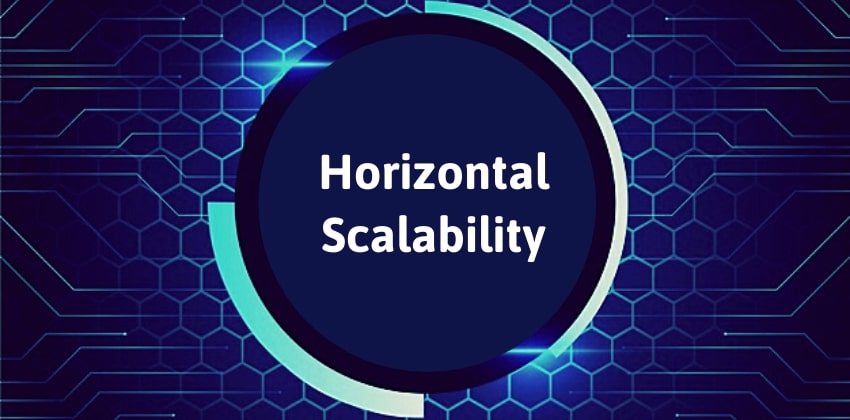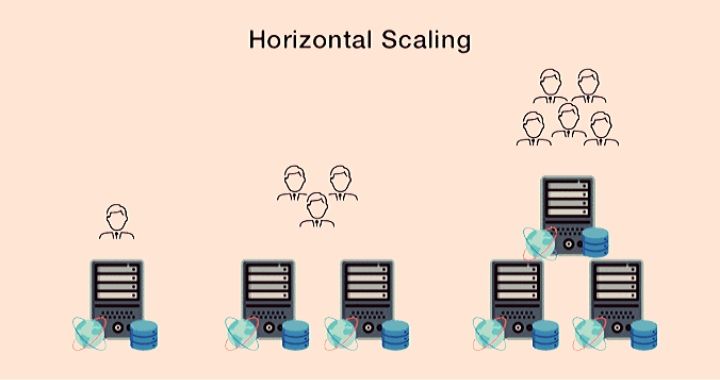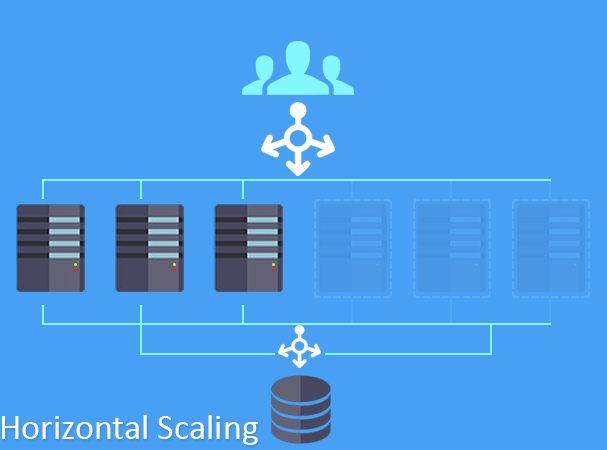
As digital systems expand, the demand for efficient resource management increases. To keep pace, many architectures rely on horizontal scalability.
It enables systems to manage growth without altering the core framework. Instead of upgrading existing hardware, it focuses on adding more machines.
Horizontal scalability plays a critical role in modern infrastructures, especially in distributed systems, cloud computing, and microservices. From tech giants handling billions of requests to startups scaling lean applications, horizontal scaling forms a foundation for resilience and performance.
What Is Horizontal Scalability?
Horizontal scalability, also known as scaling out, refers to the process of adding more nodes or machines to a system to distribute the workload. Each new machine shares the computational or storage burden, improving performance and reliability.
Unlike vertical scaling, which involves boosting resources on a single server (like adding more RAM or CPU), horizontal scaling multiplies capacity by expanding the number of machines.
It allows software to spread processing across independent units. In cloud-native environments, it’s often the preferred scaling model due to its flexibility and cost-effectiveness.

Core Characteristics of Horizontal Scalability
1. Distributed Architecture
The system functions as a cluster of servers or nodes. Each node handles part of the data or request flow. Systems like Kubernetes, Hadoop, and Cassandra follow this model.
2. Load Balancing
Traffic or requests are distributed evenly across nodes. Load balancers ensure no single node becomes a bottleneck. This reduces latency and increases fault tolerance.
3. Statelessness
Stateless services simplify horizontal scaling. Since no session data is stored locally, any instance can handle any request. This makes replication easier and maintenance more predictable.
4. Redundancy and High Availability
More nodes mean more redundancy. If one node fails, others take over. Systems become more resilient and experience fewer downtimes.
5. Elastic Growth
Horizontal scalability supports dynamic scaling. Resources can be increased or decreased based on demand. Auto-scaling in cloud services like AWS and Azure is a common use case.
Use Cases Where Horizontal Scalability Works Best
1. Cloud-Native Applications
Cloud platforms are designed for horizontal growth. Resources are provisioned across virtual machines or containers. Serverless functions and container orchestration scale horizontally by default.
2. E-commerce Platforms
Traffic spikes during sales or holidays are common. Horizontal scalability ensures the site remains responsive, even during peak loads.
3. Social Media Networks
User bases can grow rapidly. Horizontal scaling handles real-time updates, feeds, media uploads, and messaging without degrading performance.
4. Big Data Processing
Frameworks like Apache Hadoop and Spark split large datasets across nodes. Tasks are processed in parallel, reducing time and computational strain.
5. SaaS Products
Software delivered via the cloud often serves thousands to millions of users. Horizontal scaling lets the infrastructure adjust in real time as demand fluctuates.
Key Advantages of Horizontal Scalability

1. Cost Efficiency Over Time
Commodity hardware can replace expensive, high-end machines. As demand increases, additional inexpensive nodes are added. This allows for better long-term budget control.
2. Improved Fault Tolerance
If a single node fails, others continue processing. Load balancers reroute requests, and the system remains operational. Redundancy increases service availability.
3. Easier Maintenance and Upgrades
Upgrades can happen node by node. Downtime is minimized, and risk is distributed. Replacing or patching a node becomes a safe process without interrupting the entire service.
4. Scalability on Demand
Cloud providers support horizontal scaling as a service. Infrastructure automatically adapts to traffic or workload changes. Auto-scaling groups, Kubernetes HPA, and serverless functions are examples.
5. Parallel Processing
Workload gets divided across nodes. Tasks run simultaneously, speeding up completion. This is especially useful for high-performance computing and large-scale data analysis.
6. Geographic Distribution
Horizontal scaling supports deployment across multiple regions. Latency decreases when data is served closer to the user. Geo-redundancy also improves disaster recovery.
Disadvantages of Horizontal Scalability
1. Increased Complexity
Managing multiple machines or containers introduces complexity. System design must account for orchestration, synchronization, networking, and data consistency.
2. Configuration Overhead
Each new node requires setup, monitoring, and integration. Manual processes slow down scalability. Automation tools like Terraform or Ansible often become essential.
3. Data Consistency Challenges
In distributed systems, maintaining consistency across nodes is difficult. Techniques like eventual consistency, sharding, and replication require careful implementation.
4. Higher Latency in Cross-Node Communication
When requests must jump between nodes or databases, latency can increase. Poor network design or lack of locality awareness worsens the effect.
5. Load Balancer Bottlenecks
Improperly configured load balancers become single points of failure. They must be monitored and scaled alongside the rest of the infrastructure.
6. Licensing and Software Limitations
Some legacy software wasn’t built to scale horizontally. It may rely on local state or fail when distributed across multiple environments.
Horizontal vs Vertical Scalability
| Factor | Horizontal Scalability | Vertical Scalability |
|---|---|---|
| Scaling Method | Add more machines | Add more resources to one machine |
| Cost Over Time | Lower long-term cost | Higher long-term cost |
| Fault Tolerance | High (redundancy across nodes) | Low (single point of failure) |
| System Complexity | High | Low |
| Suitable For | Distributed systems, web apps | Simple apps, legacy systems |
| Limits | Scales almost indefinitely | Limited by hardware |
| Downtime During Scaling | Minimal | Possible downtime |
| Performance Bottlenecks | Possible network or sync delays | Possible CPU/memory saturation |
Both approaches serve different purposes. Many modern architectures combine both methods, starting with vertical scaling and moving toward horizontal as demands grow.
Tools and Technologies That Enable Horizontal Scalability
- Load Balancers: Hardware and software-based load balancers distribute traffic. Examples include NGINX, HAProxy, AWS ELB, and Google Cloud Load Balancing.
- Container Orchestration: Kubernetes, Docker Swarm, and OpenShift automate deployment, scaling, and management of containerized applications.
- Cloud Auto-Scaling Services: AWS Auto Scaling, Azure VM Scale Sets, and Google Cloud Instance Groups allow resources to scale dynamically.
- Distributed Databases: Cassandra, MongoDB, and Amazon DynamoDB support horizontal scaling of data across nodes.
- Configuration Management Tools: Tools like Ansible, Puppet, and Chef automate node provisioning and scaling workflows.
- Monitoring and Observability: Prometheus, Grafana, Datadog, and ELK Stack help track node performance and identify scaling thresholds.
Planning for Horizontal Scalability
- Define Scalability Goals: Systems should scale based on specific metrics—such as user sessions, API calls, or data throughput.
- Choose Stateless Architecture: Stateless services simplify load balancing and fault tolerance. If state is required, externalize it using databases or caches.
- Automate Provisioning: Manual scaling slows response to traffic spikes. Automation tools accelerate node creation, configuration, and teardown.
- Design for Fault Isolation: Avoid cascading failures. Segment nodes logically and architect services with failure boundaries.
- Use Scalable Storage: Block storage rarely scales well across nodes. Distributed file systems like Amazon S3, HDFS, or GlusterFS better support horizontal models.
- Implement Monitoring and Alerts: Identify performance bottlenecks early. Trigger alerts when systems hit thresholds for memory, latency, or CPU usage.
Real-World Examples of Horizontal Scalability
1. Netflix: Handles billions of viewing hours by distributing workloads across microservices and AWS instances. Auto-scaling and caching maintain performance during traffic surges.
2. Amazon: E-commerce scaling spans search, payment, recommendations, and inventory systems. Each function runs on clusters that grow or shrink on demand.
3. Facebook: Supports billions of interactions daily. Load balancing and distributed databases maintain fast response times globally.
4. Slack: Uses containerized microservices to isolate failures and scale channels, messages, and user sessions independently.
When Not to Use Horizontal Scalability
- Small workloads: Simple applications may not justify the complexity.
- Legacy software: Applications that rely on shared memory or local state can fail when distributed.
- Tight budgets: While long-term savings are possible, upfront setup may incur higher costs.
- Low-latency systems: Distributed designs can introduce unwanted delays in real-time systems without proper optimization.
Conclusion
Horizontal scalability empowers systems to meet modern performance demands through distributed growth. By adding more machines instead of upgrading a single one, it fosters resilience, load distribution, and service availability.
While it introduces new layers of complexity, its benefits outweigh the challenges for applications requiring elasticity, high uptime, and global reach.
Organizations planning long-term growth or running variable workloads benefit the most. Success depends on smart design, proper tooling, and a solid understanding of distributed system behaviors.
Also Read:
